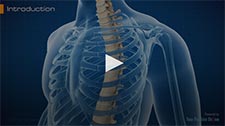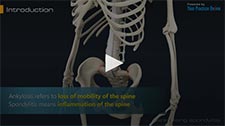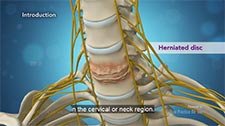Spine

Normal Anatomy of the Spine
The spine also called the back bone is designed to give us stability, smooth movement as well as providing a corridor of protection for the delicate spinal cord. It is made up of bony segments called vertebra and fibrous tissue called inter vertebral discs.
For more information about Spine Anatomy, click on below tabs.
Conditions
Back Pain
The incidence of back pain has drastically increased. Approximately 90% of Americans experience back pain at different stages of their life. In America, the annual expenditure for the treatment of back pain is approximately $50 billion. Back pain is not a disease; rather it is a symptom due to an underlying pathology.
For more information about Back Pain, click on below tab.
Neck Pain
The cervical spine comprises of the first 7 vertebrae. It supports the weight of the head and allows its smooth movement. Neck pain refers to pain or discomfort resulting from abnormalities or injuries to any of the structures in the neck including the muscles, ligaments, nerves, bones and vertebral joints. Neck pain is one of the most common health problems experienced by individuals, at some point of their lives.
For more information about Neck Pain, click on below tab.
Spine Trauma
Spine trauma is damage to the spine caused from a sudden traumatic injury caused by an accidental fall or any other physical injury. Spinal injuries may occur while playing, performing normal activities, operating heavy machines, lifting heavy objects, driving automobiles, or when you suffer a fall. Injury to spine may cause various conditions including fractures, dislocation, partial misalignment (subluxation), disc compression (herniated disc), hematoma (accumulation of blood) and partial or complete tears of ligaments.
For more information about Spine Trauma, click on below tab.
Vertebral Fractures
Back pain is an indication of stress fractures known as vertebral compression fractures. Vertebral compression fractures occur when the normal vertebral body of the spine is squeezed or compressed to a smaller height. The bone collapses when too much pressure is placed on the vertebrae, resulting in pain, limited mobility, height loss, and spinal deformity.
For more information about Vertebral Fractures, click on below tab.
Scoliosis
Scoliosis is a condition where the spine or back bone is curved sideways instead of appearing in a straight line. The most common type of scoliosis is adolescent idiopathic scoliosis which occurs after age 10 and is seen more frequently in girls than boys.
For more information about Scoliosis, click on below tab.
Cervical Radiculopathy and Myelopathy
The spine, also called the back bone, is designed to give us stability, smooth movement, as well as providing a corridor of protection for the delicate spinal cord. It is made up of bony segments called vertebrae and fibrous tissue called intervertebral discs.
For more information about Cervical Radiculopathy and Myelopathy, click on below tab.
Spondylolisthesis
The spine, also called the back bone, is designed to give us stability, smooth movement, as well as providing a corridor of protection for the delicate spinal cord. It is made up of bony segments called vertebrae and fibrous tissue called intervertebral discs. The vertebrae and discs form a column from your head to your pelvis providing symmetry and support to the body.
For more information about Spondylolisthesis, click on below tab.
Spine Deformities
Scoliosis is a condition characterized by abnormal curvature of the spine causing a deviation to one side. It causes a physical deformity making the spine look like the letter “C” or “S” instead of the letter “I”.
For more information about Spine Deformities, click on below tab.
Degenerative Disc Disease
Degenerative disc disease (DDD) refers to gradual deterioration of the intervertebral discs between the vertebrae. DDD is a misnomer as it is not actually a disease but a condition that affects the strength, resiliency and structural integrity of the intervertebral discs due to advancing age, trauma, injury, repetitive movement, improper posture, or poor body mechanics.
For more information about Degenerative Disc Disease, click on below tab.
Cervical Herniated Disc
Herniation of a disc is an anomalous spine condition characterized by leakage of the inner contents of the intervertebral disc, due to cracks in its outer wall. Herniated disc is commonly seen in the cervical or neck region, a condition called cervical herniated disc (CHD).
For more information about Cervical Herniated Disc, click on below tab.

Ankylosing Spondylitis
The term ankylosis refers to loss of mobility of the spine, whereas spondylitis means inflammation of the spine. Therefore, ankylosing spondylitis is a condition where chronic inflammation of the spine and sacroiliac joint results in complete fusion of the vertebrae leading to pain and stiffness in the spine.
For more information about Ankylosing Spondylitis, click on below tabs.
Procedures
Spine Injections
Spine injection is a nonsurgical treatment modality recommended for treatment of chronic back pain. Injection of certain medicinal agents relieves the pain by blocking the nerve signals between specific areas of the body and the brain. The treatment approach involves injections of local anaesthetics, steroids, or narcotics into the affected soft tissues, joints, or nerve roots.
For more information about Spine Injections, click on below tab.
Spinal Deformity Surgery
The Spine or backbone provides stability to the upper part of our body. It helps to hold the body upright. It consists of several irregularly shaped bones, called vertebrae appearing in a straight line. The spine has two gentle curves, when looked from the side and appears to be straight when viewed from the front. When these curves are exaggerated, pronounced problems can occur such as back pain, breathing difficulties and fatigue and the condition will be considered as deformity.
For more information about Spinal Deformity Surgery, click on below tab.

Anterior Cervical Discectomy with Fusion (ACDF)
Anterior cervical discectomy and fusion (ACDF) is a surgical procedure used in the management of spinal cord and nerve root compression secondary to certain disorders such as degenerative disc disease, herniated disc, spondylosis, and spinal stenosis. ACDF reduces the neck and arm pain and provides stability to the spine.
For more information about Anterior Cervical Discectomy with Fusion (ACDF), click on below tabs.
Cervical Disc Replacement
Artificial cervical disc replacement surgery is an alternative to spinal fusion surgery, where the damaged intervertebral disc in the neck is removed and replaced with a disc implant. This surgery relieves neck pain as well as restores the normal range of motion of the neck.
For more information about Cervical Disc Replacement, click on below tab.
Lumbar Discectomy
Lumbar discectomy is a surgical procedure performed for the removal of a herniated or ruptured disc from the lumbar (lower) region. Intervertebral discs are fibrocartilaginous cushions between adjacent vertebrae. The normal intervertebral disc is composed of a semi-liquid substance (nucleus pulposus) at the center surrounded by a fibrous ring (annulus fibrosis).
For more information about Lumbar Discectomy, click on below tab.
Lumbar Laminectomy
Lumbar laminectomy is a surgical procedure to relieve the pressure over the spinal nerves which results in pain and numbness in the legs. The narrowing of the spinal canal can occur either due to wear and tear or degenerative changes of the different parts of the spine.
For more information about Lumbar Laminectomy, click on below tab.
Spinal Fusion
Lumbar laminectomy is a surgical procedure to relieve the pressure over the spinal nerves which results in pain and numbness in the legs. The narrowing of the spinal canal can occur either due to wear and tear or degenerative changes of the different parts of the spine.
For more information about Spinal Fusion, click on below tab.











